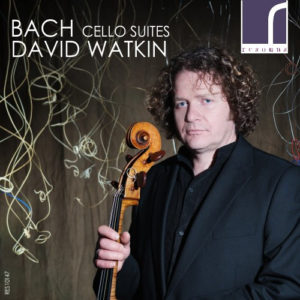
David Watkin Bach Cello Suites (Resonus RES10147) Rec.2013
The Cellist.
David Watkin is particularly highly rated as a period cellist. Of note, his teachers included not just period specialist Anna Bylsma but also Amaryllis Fleming and both William and Anthony Pleeth, a veritable who’s who. He has held senior positions in mainstream orchestras such as the Philharmonia. In addition, several with noted period ensembles including the English Baroque Soloists and the Orchestra of the Age of Enlightenment. Watkin chooses to tackle the Suites using not just Baroque cellos but also a Baroque bow. The cello for the first five suites is a 1670 Rugeri, and for the 6th a 5 string 1600 Amati.
The Recording.
This recording has been showered with plaudits and awards. Not only the Gramophone Baroque Instrumental award in 2015, but in the same year the Instrumental Winner in BBC Magazine. It is therefore a brave person who chooses to negatively review this performance. Fortunately, I have no need to do so as I also find it an out and out success!
Watkin committed these recordings to disc late in his career (about more see anon). Consequently, it is immediately evident within the first few movements that they are deeply considered readings. In fact, produced after many years familiarity with the Suites. What they are not, are carbon copies of anyone else’s interpretations. Indeed Watkin has much to say on his own terms.
His readings are generally brisk but there is time taken where the slower dance movements demand it. Furthermore, there is clear differentiation of movement styles.
The third Suite.
Firstly, the 3rd Suite, is one that I admit perhaps sometimes doesn’t register as strongly for me as some others. It is a good example of this differentiation. In that same Suite he plays the Prelude with a frantic pace to it, creating real excitement. In his booklet notes he comments on this, suggesting that it is typically played in a slow grand style. He then goes on to explain why there is plenty of evidence to suggest that was not Bach’s intention.
A quick comparison with some other noted recordings suggested to me that older versions are for sure more stately. There are a number of modern recordings that do inject some zip, but Watkin for sure is even zippier!
He also uses this Prelude to indicate how we can create our own image or story of what the music could represent. I like this suggestion as it reinforces for me that the Suites do not have to be approached and viewed as just dry academic exercises.
Some surprises.
Time and again I found in my listening to Watkin that there were delightful surprises in terms of colour, pacing, leaning into phrases, space, overtones and so on. Frankly he plays them like his life depends on them. At times in the Gigues (Suite No.3 again being a good example) I thought his energetic and fast approach was threatening to outstrip his fingers capabilities, but somehow he comes through the process unscathed. Picking out specific highlights is hard given the overall standard, but I could listen to his 5th and 6th Suite Sarabandes on permanent repeat, and indeed would add the sublime 6th Suite’s Allemande to that list.
The recording venue.
The recording quality is superb with a beautiful acoustic from the Robin Chapel in Edinburgh. The instruments are also superb. It is a privilege listening to the earthy sound of the Amati which can still sound sweet and rich when required. There is none of the astringency that some cellos can produce. I mentioned that this is a late recording for Watkin and that he plays like his life depends on it. In many ways it was that important, as sadly it was his last, since he already knew he would have to stop performing due to the onset of scleroderma in 2013. This is a chronic condition affecting his fingers causing blood vessels to break when pressing down on his fingers.
Conclusion.
In conclusion, Watkin can be proud that he left us this recording, a fitting testament to his art, and for me now the benchmark in period recordings. Indeed meriting its place at the top table of all recordings.
Mark.
David Watkin. Resonus CD RES10146 Released 2015.
Recorded Robin chapel Edinburgh over 7 days 26thMarch -12thDec 2013.
24 bit 96 kHz HR recording.
Cello played Suites 1-5 is by Francesco Rugeri circa 1670
Cello played Suite 6 by Antonio and Hieronymous Amati c 1600
Baroque bow by John Waterhouse after Tononi c. 1725.
Brief Review.
This recording may be considered an “authentic” and historically accurate rendition, with gut strings, baroque bow and period instrumentation. As far as I can tell from photos he does not use an end pin but the bow although held forward of the frog is held from above.
I agree entirely with Mark’s comments above, so will be brief. The two additional comments I would make is firstly, that there is a sense of pulse throughout Watkins renditions. Secondly, there is a steady waxing and waning of the phrasing within repeated patterns. No surprises then that videos of master classes that Watkin has given reveal the thinking and intention behind this characteristic of the recordings. In the videos he talks of slurring patterns and of “riding the wave” regards phrasing. This link will take you to one of these videos.
https://www.youtube.com/watch?v=pLhIL5VT8pw
Definitely one to savour and enjoy!
Charles.